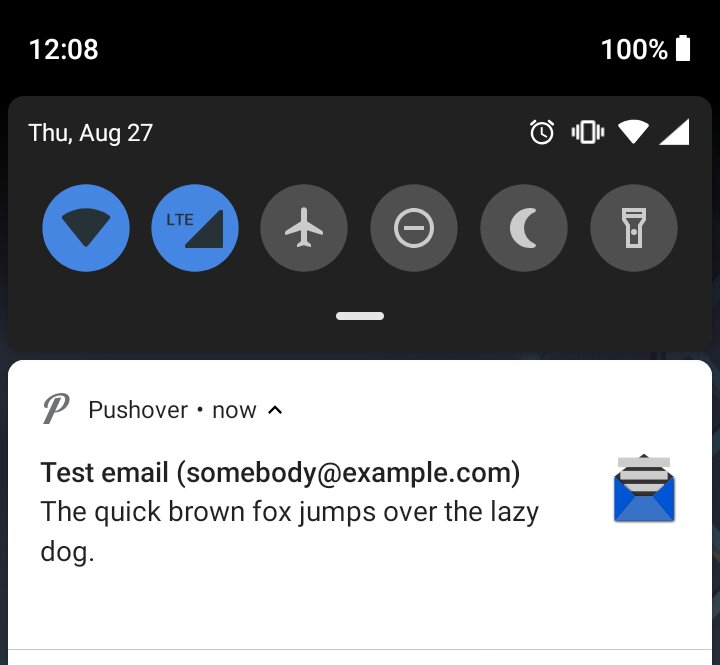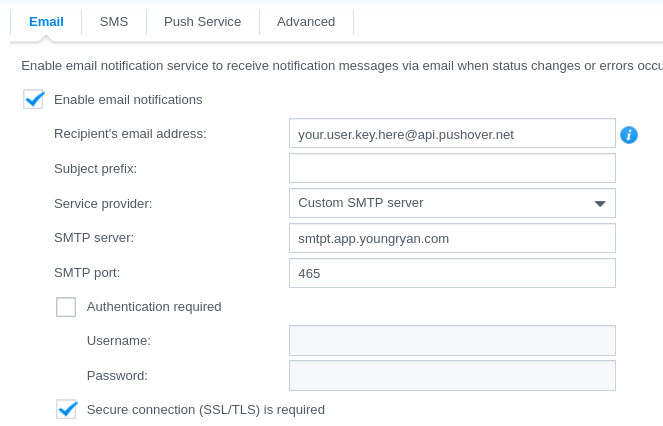
Security News
Oracle Drags Its Feet in the JavaScript Trademark Dispute
Oracle seeks to dismiss fraud claims in the JavaScript trademark dispute, delaying the case and avoiding questions about its right to the name.
github.com/yoryan/smtp-translator
![]()
SMTP Translator is a custom SMTP server that converts all emails it receives into Pushover notifications - a faster, simpler, and more contemporary alternative to email messages. No more replicating your Gmail password to the email daemons on all of your Linux boxes!
SMTP Translator has been succeeded by my Mailrise project, which can push to practically any service - not just Pushover - using the Apprise library.

With an SMTP Translator instance set as your SMTP relay, send an email to (your user key here)@pushover.net. Then, instead of routing the email to Pushover via
the conventional email network, SMTP Translator submits it directly to the
Pushover API. You can make up any sender addresses you want, since they never
touch the public email system.
Please note that with SMTP Translator as your sole smarthost, your system will not be able to send email to non-Pushover destinations.
As of June 6, 2021, the demo server formerly available at smtpt.youngryan.com has been discontinued.
First, install SMTP Translator into your GOPATH:
$ go get -u github.com/YoRyan/smtp-translator
To start the server, you need to specify the Pushover app token it will use. You
do this by setting the PUSHOVER_TOKEN environment variable:
$ export PUSHOVER_TOKEN=xxx
$ sudo smtp-translator
Optionally, you can specify your own listening address and advertised hostname.
$ smtp-translator -addr 127.0.0.1:2525 -hostname My-Host-Not-Root
You may also insert the following flags directly after your user token to further customize the notification:
>device to send the notification to a particular
device (or, by inserting comma
separators, multiple devices)#priority to set the notification
priority (from -2 to 2)%retry to set the retry interval for emergency priority notifications$expire to set the expiration time for emergency priority notifications!sound to set the notification toneFor example, sending an email to
uQiRzpo4DXghDmr9QzzfQu27cmVRsG>phone!incoming@pushover.net will route the
notification to your phone device and play the incoming sound.
If the email contains an image attachment that is within Pushover's 2.5 MB limit, SMTP Translator will attach it to the Pushover notification.
No catch. I promise that the code on this repository is what I run on my server, and that I do not log messages or metadata. But if you would prefer some more privacy, you are of course free to acquire your own app token and host your own instance.
smtpt.youngryan.com support encryption?Yes. To use TLS encryption, make note of the following table:
| Port | Encryption |
|---|---|
| 25 | STARTTLS (optional) |
| 465 | TLS-on-connect |
| 587 | STARTTLS (mandatory) |
In theory, I could still read your messages. Email, by its nature, cannot be end-to-end encrypted.
Double-check the token in your recipient address - it is easy to confuse an app token for a user or group token.

Run dpkg-reconfigure exim4-config and answer the following:
$ mailx -s 'Test Email' 'your.user.key.here@pushover.net'
Hello, World!
# cat >>/etc/postfix/main.cf
relayhost = [smtpt.youngryan.com:587]
smtp_tls_security_level = verify
smtp_tls_mandatory_ciphers = high
smtp_tls_verify_cert_match = hostname
$ mailx -s 'Test Email' 'your.user.key.here@pushover.net'
Hello, World!
# cat >>/etc/mail/sendmail.mc; /etc/mail/make
define(`SMART_HOST', `smtpt.youngryan.com')dnl
define(`RELAY_MAILER', `esmtp')dnl
define(`RELAY_MAILER_ARGS', `TCP $h 587')dnl
define(`confAUTH_MECHANISMS', `CRAM-MD5')dnl
$ mailx -s 'Test Email' 'your.user.key.here@pushover.net'
Hello, World!
SMTP Translator can be run inside Docker, and an official image is available from Docker Hub. This image listens on port 25. It will not run out of the box; you need to supply the PUSHOVER_TOKEN environment variable to get the daemon to start:
# docker pull yoryan/smtp-translator
# docker run -e PUSHOVER_TOKEN=xxx -t yoryan/smtp-translator
To pass additional command-line arguments, use /app/smtp-translator as the binary path:
# docker run -it yoryan/smtp-translator /app/smtp-translator -help
If you want to enable TLS when running SMTP Translator inside a Docker container, you will need to use bind mounts to supply the certificate files.
Passing the -multi flag will instruct SMTP Translator to read the app token
from the sender's email address instead of the environment variable. In this
mode, all sender addresses must be in the form of (app token)@pushover.net.
You do not need to set PUSHOVER_TOKEN in this mode.
To quickly generate your own cert:
$ openssl req -newkey rsa:4096 -nodes -sha512 -x509 -days 3650 -nodes -out mycert.pem -keyout mycert.key
(This is self-signed, so production email clients will reject it by default. For an authentic certificate, request one from a service like Let's Encrypt.)
There are three possible operating modes depending on whether you want to encrypt the entire session or kickstart unencrypted connections with STARTTLS - and if you use STARTTLS, whether or not to mandate encryption. For a historical discussion of the differing standards, see this overview by Fastmail.
| Arguments | Mode |
|---|---|
-tls-cert mycert.pem -tls-key mycert.key | Immediate TLS encryption |
-tls-cert mycert.pem -tls-key mycert.key -starttls | Initial connection unencrypted, optional upgrade to TLS |
-tls-cert mycert.pem -tls-key mycert.key -starttls-always | Initial connection unencrypted, mandatory upgrade to TLS |
To password-protect your server, use the -auth switch to provide a path to a
credentials file, where each line represents an authorized login in the form of
username:password.
$ cat >mycreds.txt <<EOF
ryan:hunter2
einstein:letmein
EOF
$ chmod 600 mycreds.txt
$ smtp-translator -addr :2525 -auth mycreds.txt
A valid login will then be required to submit any messages. Provide usernames and passwords to your SMTP clients as you would for any SMTP server that requires authentication. If not using TLS, clients must support the CRAM-MD5 authentication method so that they do not reveal passwords in transit.
FAQs
Unknown package
Did you know?

Socket for GitHub automatically highlights issues in each pull request and monitors the health of all your open source dependencies. Discover the contents of your packages and block harmful activity before you install or update your dependencies.

Security News
Oracle seeks to dismiss fraud claims in the JavaScript trademark dispute, delaying the case and avoiding questions about its right to the name.

Security News
The Linux Foundation is warning open source developers that compliance with global sanctions is mandatory, highlighting legal risks and restrictions on contributions.

Security News
Maven Central now validates Sigstore signatures, making it easier for developers to verify the provenance of Java packages.